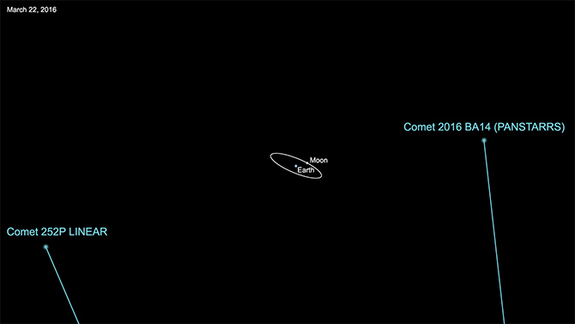
The 4.3 meter Discovery Channel Telescope (DCT) is located at Happy Jack, Ariz., 40 miles southeast of Flagstaff.
Credit: Lowell Observatory/DCT
Not one, but two comets will fly past Earth later this month, one of which will be the third closest comet flyby to occur in recorded history. Both comets seem to share astonishingly similar orbits, which is an interesting clue to their origin, but the second object’s true identity was confirmed by the 4.3-meter Discovery Channel Telescope (DCT) at Lowell Observatory, near Flagstaff in Arizona.
PHOTOS: Discovery Channel Telescope’s Epic Cosmic View
Discovered by the University of Hawaii’s PanSTARRS telescope on Maui, Hawaii, in January this year, Comet P/2016 BA14 was initially identified as an asteroid, but a joint University of Maryland and Lowell Observatory team used the DCT to zoom in on the interplanetary visitor to find it has a tail, a sign that it is in fact a small comet.
This discovery coincides with the expected flyby of Comet 252P/LINEAR on March 21, which will swing past our planet at a close (yet safe) distance of 3.3 million miles (approximately 14 times the Earth-moon distance). 252P was discovered in 2000 by the Massachusetts Institute of Technology’s Lincoln Near Earth Asteroid Research (LINEAR) survey and is known to be around 250 meters wide. Comet P/2016 BA14 is thought to be around half that size and will zip past the following day, but will come closer to Earth flying by at a distance of 2.2 million miles (9 times the Earth-moon distance).
The P/2016 BA14 flyby will be the closest recorded comet encounter since the flyby of comet D/1770 L1 (Lexell) in 1770 and C/1983 H1 (IRAS-Araki-Alcock) in 1983.
Already this event is notable, but the double encounter is likely more than just a coincidence. In fact, these two objects were likely once part of the same comet.
PHOTOS: Discovery Channel Telescope Approaches ‘First Light ‘
“Comet P/2016 BA14 is possibly a fragment of 252P/LINEAR,” said Paul Chodas, manager of NASA’s Center of NEO Studies (CNEOS) at the Jet Propulsion Laboratory in Pasadena, Calif., in a NASA news release . “The two could be related because their orbits are so remarkably similar.
“We know comets are relatively fragile things, as in 1993 when comet Shoemaker-Levy 9 was discovered and its pieces linked to a flyby of Jupiter. Perhaps during a previous pass through the inner-solar system, or during a distant flyby of Jupiter, a chunk that we now know of as BA14 might have broken off of 252P.”

Comet 252P/LINEAR will safely fly past Earth on March 21, 2016, at a range of about 3.3 million miles (5.2 million kilometers). The following day, comet P/2016 BA14 will safely fly by our planet at a distance of about 2.2 million miles (3.5 million kilometers).
Credit: NASA/JPL-Caltech
Follow-up observations of 252P/LINEAR and P/2016 BA14 by the NASA/ESA Hubble Space Telescope and NASA’s Infrared Telescope Facility will try to find further hints as to both comets’ origins, perhaps proving they are both chunks of the same icy object that was somehow torn apart.
As far as comets go, neither object is particularly massive and neither have orbits in the future that pose a threat to Earth.
“March 22 will be the closest comet P/2016 BA14 gets to us for at least the next 150 years,” added Chodas. “Comet P/2016 BA14 is not a threat. Instead, it is an excellent opportunity for scientific advancement on the study of comets.”
PHOTOS: 7 Intimate Close Encounters with Comets
Because they are so small, these cometary lightweights will be hard to observe, so only the most powerful, professional-grade ground-based telescopes can spot them.
The Discovery Channel Telescope saw “frst light” in 2012 and is the fifth largest optical/near-infrared telescope in the continental United States. It is designed to track down objects orbiting the sun as far afield as the Kuiper Belt (beyond Pluto), including comets flying through the solar system, but also specializes in the study of dwarf galaxies.
It is powerful telescopes like the DCT that are critical to the safeguarding of Earth from incoming comet and asteroid threats and high-resolution studies of this possible comet “twin” will help us not only understand the composition and structure of these icy bodies, they will also provide a clue as to how comets form and how many more are out there.
Source: JPL-Caltech

Comments are closed.